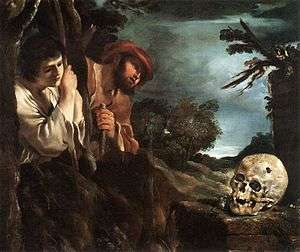Et in Arcadia ego (Guercino)
Et in Arcadia ego (also known as The Arcadian Shepherds) is a painting by the Italian Baroque artist Giovanni Francesco Barbieri (Guercino), from c. 1618–1622. It is now on display in the Galleria Nazionale d'Arte Antica of Rome.
| Et in Arcadia ego | |
|---|---|
 | |
| Artist | Giovanni Francesco Barbieri (Guercino) |
| Year | 1618–1622 |
| Medium | Oil on canvas |
| Dimensions | 81 cm × 91 cm (32 in × 36 in) |
| Location | Galleria Nazionale d'Arte Antica, Rome |
Description
The painting shows two young shepherds staring at a skull, with a mouse and a blowfly, placed onto a cippus with the words "Et in Arcadia ego" ("I too [was] in Arcadia"). The phrase appears for the first time in art and architecture in this work. The iconography of the memento mori theme symbolised in art by the skull was rather popular in Rome and Venice since Renaissance times.
Elias L. Rivers suggested the phrase "Et in Arcadia ego" is derived from a line from Daphnis' funeral in Virgil's Fifth Eclogue Daphnis ego in silvis ("Daphnis was I amid the woods"), and that it referred to the dead shepherd within the tomb, rather than Death itself.[1]
Mentioned for the first time in the collection of Antonio Barberini in 1644, the painting was later acquired by Colonna of Sciarra (1812), being attributed to Bartolomeo Schedoni until 1911. Nicolas Poussin also made two paintings on the topic of Et in Arcadia ego, less than two decades later.
The painting is connected with Guercino's The Flaying of Marsyas by Apollo in Palazzo Pitti (1618), where the same group of shepherds is present.
In literature and pop culture
Goethe's Italian Journey (1816) has "Et In Arcadia Ego" as its motto. Goethe viewed Guercino's painting in Cento (17 October 1786).
Hans Christian Andersen's "Improvisatoren" (1835) in chapter 13 two of the main characters discuss the painting.
"Et in Arcadia Ego" is the title of Book One of Evelyn Waugh's Brideshead Revisited (1945).
Cormac McCarthy's "Blood Meridian" in chapter 9. It is the name of the judge's gun.
"Et In Arcadia Ego" is the title of the ninth and tenth episodes of the first season of Star Trek: Picard
References
- Elias L. Rivers, "Foreword", to Bruno Mario Damiani, Bárbara Louise Mujica, Et In Arcadia Ego: Essays on Death in the Pastoral Novel (Lanham and New York: University Press of America, 1990). ISBN 0-8191-7772-5